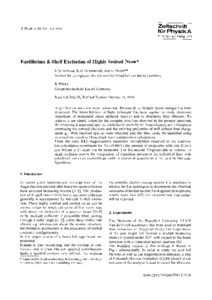Aufsatz

Equilibrium K-shell excitation of highly ionized neon
Zusammenfassung
Augerelectron emission from foil-excited Ne-ions (6 to 10 MeV beam energy) has been
measured. The beam-foil time-of-flight technique has been applied to study electronic transitions of metastable states (delayed spectra) and to determine their lifetimes. To achieve a line identification for the complex structure observed in the prompt spectrum, the spectrum is separated into its isoelectronic parts by an Augerelectron-ion coincidence correlating the emitted electrons and the emitting projectiles of well defined final charge states q_f. Well resolved spectra were obtained and the lines could be identified using intermediate coupling Dirac-Fock multiconfiguration calculations. From the total KLL-Augerelectron transition probabilities observed in the electronion coincidence experiment for Ne (10 MeV) the amount of projectiles with one K-hole just behind a C-target can be estimated. For foil-excited Ne-projectiles in contrast to single collision results the comparison of transition intensities for individual lines with calculated transition probabilities yields a statistical population of Li- and Be-like configurations.
measured. The beam-foil time-of-flight technique has been applied to study electronic transitions of metastable states (delayed spectra) and to determine their lifetimes. To achieve a line identification for the complex structure observed in the prompt spectrum, the spectrum is separated into its isoelectronic parts by an Augerelectron-ion coincidence correlating the emitted electrons and the emitting projectiles of well defined final charge states q_f. Well resolved spectra were obtained and the lines could be identified using intermediate coupling Dirac-Fock multiconfiguration calculations. From the total KLL-Augerelectron transition probabilities observed in the electronion coincidence experiment for Ne (10 MeV) the amount of projectiles with one K-hole just behind a C-target can be estimated. For foil-excited Ne-projectiles in contrast to single collision results the comparison of transition intensities for individual lines with calculated transition probabilities yields a statistical population of Li- and Be-like configurations.
Zitierform
In: Zeitschrift für Physik / A. - Berlin [u.a.] : Springer, 289.1979, S. 245-254Zitieren
@article{urn:nbn:de:hebis:34-2008100824429,
author={Schumann, Steffen and Groeneveld, Karl-Ontjes and Nolte, G. and Fricke, Burkhard},
title={Equilibrium K-shell excitation of highly ionized neon},
year={1979}
}
0500 Oax 0501 Text $btxt$2rdacontent 0502 Computermedien $bc$2rdacarrier 1100 1979$n1979 1500 1/eng 2050 ##0##urn:nbn:de:hebis:34-2008100824429 3000 Schumann, Steffen 3010 Groeneveld, Karl-Ontjes 3010 Nolte, G. 3010 Fricke, Burkhard 4000 Equilibrium K-shell excitation of highly ionized neon / Schumann, Steffen 4030 4060 Online-Ressource 4085 ##0##=u http://nbn-resolving.de/urn:nbn:de:hebis:34-2008100824429=x R 4204 \$dAufsatz 4170 7136 ##0##urn:nbn:de:hebis:34-2008100824429
<resource xsi:schemaLocation="http://datacite.org/schema/kernel-2.2 http://schema.datacite.org/meta/kernel-2.2/metadata.xsd"> 2008-10-08T10:47:35Z 2008-10-08T10:47:35Z 1979 0340-2193 0930-1151 0939-7922 urn:nbn:de:hebis:34-2008100824429 http://hdl.handle.net/123456789/2008100824429 685454 bytes application/pdf eng Urheberrechtlich geschützt https://rightsstatements.org/page/InC/1.0/ 530 Equilibrium K-shell excitation of highly ionized neon Aufsatz Augerelectron emission from foil-excited Ne-ions (6 to 10 MeV beam energy) has been measured. The beam-foil time-of-flight technique has been applied to study electronic transitions of metastable states (delayed spectra) and to determine their lifetimes. To achieve a line identification for the complex structure observed in the prompt spectrum, the spectrum is separated into its isoelectronic parts by an Augerelectron-ion coincidence correlating the emitted electrons and the emitting projectiles of well defined final charge states q_f. Well resolved spectra were obtained and the lines could be identified using intermediate coupling Dirac-Fock multiconfiguration calculations. From the total KLL-Augerelectron transition probabilities observed in the electronion coincidence experiment for Ne (10 MeV) the amount of projectiles with one K-hole just behind a C-target can be estimated. For foil-excited Ne-projectiles in contrast to single collision results the comparison of transition intensities for individual lines with calculated transition probabilities yields a statistical population of Li- and Be-like configurations. open access In: Zeitschrift für Physik / A. - Berlin [u.a.] : Springer, 289.1979, S. 245-254 Schumann, Steffen Groeneveld, Karl-Ontjes Nolte, G. Fricke, Burkhard </resource>
Die folgenden Lizenzbestimmungen sind mit dieser Ressource verbunden:
Urheberrechtlich geschützt

